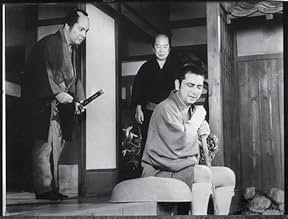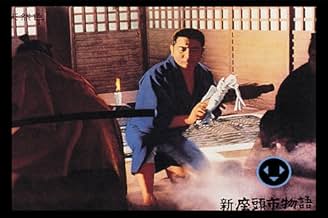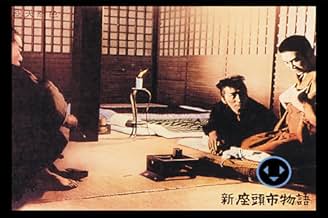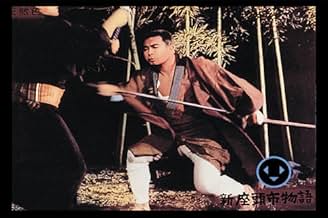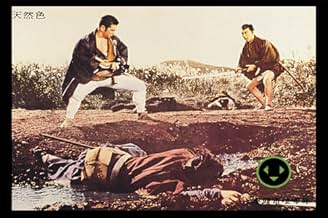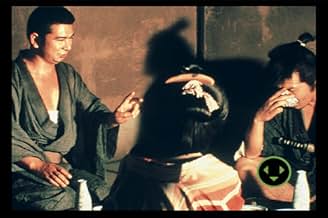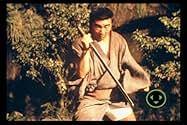IMDb RATING
7.1/10
2.1K
YOUR RATING
Zatoichi promises to deliver a maiden safely home but finds two dangerous gangs have a mysterious interest in the young girl.Zatoichi promises to deliver a maiden safely home but finds two dangerous gangs have a mysterious interest in the young girl.Zatoichi promises to deliver a maiden safely home but finds two dangerous gangs have a mysterious interest in the young girl.
- Director
- Writers
- Stars
- Director
- Writers
- All cast & crew
- Production, box office & more at IMDbPro
Featured reviews
The following review is an extract from the book "Shintaro Katsu´s Zatoichi: Complete guide to all movies", which is now available on Amazon.
"At the beginning of this film, as a filmic preface, we see how Ichi plays a game of dice (or something similar) with a small group of dishonest opponents. The latter, despite having lost, are not willing to accept defeat, but before they can react, Zatoichi makes them reluctant to even try any hostility against him. With a lightning fast movement of his shikomizue, he cuts a candle that illuminated the room vertically, leaving his opponents astonished, and leaving the room shortly afterwards in the dark (and therefore in relative equality of conditions with others who are able to see). "Darkness is my ally..." says Zatoichi again sheathing his sword in the reed.
The massive duel between the two groups of yakuza recalls by its atmosphere and stylistic characteristics the great Italo-westerns, where a solitary gunman (like Clint Eastwood in Sergio Leone's "Dollar trilogy") must face several enemies at the same time. Leone and other western masters were profusely inspired by the Japanese chambara. The equivalence and parallels between samurais or ronins and solitary cowboys or outlaws are undeniable."
"At the beginning of this film, as a filmic preface, we see how Ichi plays a game of dice (or something similar) with a small group of dishonest opponents. The latter, despite having lost, are not willing to accept defeat, but before they can react, Zatoichi makes them reluctant to even try any hostility against him. With a lightning fast movement of his shikomizue, he cuts a candle that illuminated the room vertically, leaving his opponents astonished, and leaving the room shortly afterwards in the dark (and therefore in relative equality of conditions with others who are able to see). "Darkness is my ally..." says Zatoichi again sheathing his sword in the reed.
The massive duel between the two groups of yakuza recalls by its atmosphere and stylistic characteristics the great Italo-westerns, where a solitary gunman (like Clint Eastwood in Sergio Leone's "Dollar trilogy") must face several enemies at the same time. Leone and other western masters were profusely inspired by the Japanese chambara. The equivalence and parallels between samurais or ronins and solitary cowboys or outlaws are undeniable."
This was the fifth Zatôichi film in just two years. It's been a while since I saw the last one in the series, but they're great fun. Simpler than the previous films, and also far more conventional as an action-adventure, "Zatôichi kenka-tabi" ('Zatôichi on the Road', 1963) stays true to its name, although it could've been called 'The Road To Edo' as well: a road movie of chasing and hiding, of fighting and fleeing to fight again; hide and seek, and pretense. The film greatly picks up in between the fights during the scene at the inn, which is well-made. And it is this sense of, well, it's not predictability because that sounds negative... let's say 'familiarity', that makes it so easy for the viewer to jump right into it – we know where it comes from and where it goes.
It's become a running joke by now to have Zatôichi evade fighting, only to be eluded to a situation where he has to fight. He think he's only on a trip to Edo, while he's taken there to help out at a clan fight. The film is a crescendo of provocation until Zatôichi finally unsheathes his sword. This, of course, makes the films work in the long run: we need a sympathetic character, and having a character who would run around killing people for pleasure doesn't really cut it here. Yet there is a genuinely tragic undersong here: he doesn't search for trouble yet the trouble finds him, and still he is looking for trouble, as he says in the film, by having learnt to fight with the sword.
My favourite moment is the one with the white sunshades on the slope, and Zatôichi running with the children in imitation of the ending of "Det sjunde inseglet" (1957), the other one is the Kurosawan climax.
I do wonder when we're going to have a decent villain, though.
It's become a running joke by now to have Zatôichi evade fighting, only to be eluded to a situation where he has to fight. He think he's only on a trip to Edo, while he's taken there to help out at a clan fight. The film is a crescendo of provocation until Zatôichi finally unsheathes his sword. This, of course, makes the films work in the long run: we need a sympathetic character, and having a character who would run around killing people for pleasure doesn't really cut it here. Yet there is a genuinely tragic undersong here: he doesn't search for trouble yet the trouble finds him, and still he is looking for trouble, as he says in the film, by having learnt to fight with the sword.
My favourite moment is the one with the white sunshades on the slope, and Zatôichi running with the children in imitation of the ending of "Det sjunde inseglet" (1957), the other one is the Kurosawan climax.
I do wonder when we're going to have a decent villain, though.
Fierce fighter, but humble, deferential to a fault, carefully rewards goodness only when he cannot be thanked, protective of innocents --- much like our finest cowboy heroes (Shane, Coop in Noon, Clint).
My wife likes The Shield for the same reasons she likes Hollywood's version of Cosa Nostra: protect the innocent, swiftly and without recourse punish the guilty.
If Michael Corleone ran the justice system, would O.J. be playing golf? Would the beaten, threatened common-law wife be turned away from the police station with "until he actually kills you, the ACLU won't allow us to do anything?"
Just saw the first sequel episode, #2. The print I found appears to be a crude chop job by Janus Films, that marketer having rudely hacked off the correct ending.
My wife likes The Shield for the same reasons she likes Hollywood's version of Cosa Nostra: protect the innocent, swiftly and without recourse punish the guilty.
If Michael Corleone ran the justice system, would O.J. be playing golf? Would the beaten, threatened common-law wife be turned away from the police station with "until he actually kills you, the ACLU won't allow us to do anything?"
Just saw the first sequel episode, #2. The print I found appears to be a crude chop job by Janus Films, that marketer having rudely hacked off the correct ending.
When Zatoichi accidentally met an unknown dying man, who asked him to save an unknown maiden, he felt obligated. He didn't even have to promise. Time and again, he did everything in his power to save the maiden in several occassions. But when he took side on a feudal quarrel, he found himself choosing between which one to honor better: The request of a dying man or the contract he made with one of the gang leaders. You've guessed what he opted. Modern gangsters may have a different code of ethics.
This movie had some great sword-fighting sequences, as well as the usual beautiful (but kinda stupid) young woman falling for the blind gambler. I think that the most compelling sequence, though, is where he rescues the young hostage without drawing a sword. There is something about the transformation of the humble blind man to angry, sarcastic avenger that is compelling. It reminds me of those few Columbo episodes where the detective tips his hand early in the episode, for some reason.
This movie would be an excellent introduction to the series.
This movie would be an excellent introduction to the series.
Did you know
- TriviaZatoichi's katana is a shikomizue. This is a sword which is concealed within a wooden cane, thus the cane itself is both handle and scabbard.
- GoofsThe string attached to the dragonfly is visible as it lands on a bush next to Zatoichi and Mitsu, who are being attacked, and also when it returns after the fight.
- ConnectionsFeatured in Best in Action: 1963 (2019)
- How long is Zatoichi on the Road?Powered by Alexa
Details
- Release date
- Country of origin
- Language
- Also known as
- Zatoichi on the Road
- Production company
- See more company credits at IMDbPro
- Runtime
- 1h 25m(85 min)
- Sound mix
- Aspect ratio
- 2.35 : 1
Contribute to this page
Suggest an edit or add missing content

